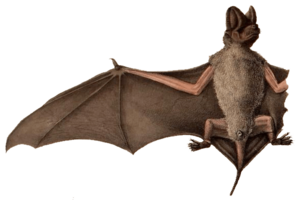Little free-tailed bat facts for kids
Quick facts for kids Little free-tailed bat |
|
|---|---|
 |
|
| Conservation status | |
| Scientific classification | |
| Genus: |
Mops
|
| Species: |
pumilus
|
The little free-tailed bat (Mops pumilus) is a small and fast-flying bat. It belongs to a group of bats called Mops and is part of the Molossidae family, also known as free-tailed bats. These bats live in many places across Africa and on islands near the continent.
Contents
What Does the Little Free-Tailed Bat Look Like?
The little free-tailed bat is one of the smallest bats in its group. It measures about 54 to 102 millimeters long from head to tail. That's roughly the size of a small candy bar!
Its fur is short. The fur on its back (dorsal fur) is dark brownish-black. The fur on its belly (ventral fur) is lighter. You might also see pale or white hairs where its wings connect to its sides. Some bats have white wings (found in north-eastern Africa), while others have dark wings (found in southern Africa).
This bat has round ears that look quite big compared to its head. Inside its ear, there's a tiny flap called a tragus. It's covered by a larger flap called the antitragus. Male bats have a special tuft of fur on their forehead. This tuft helps identify them when they are flying.
Bats from different areas can look a bit different. For example, bats in Tanzania might have longer forearms than those in South Africa or Ghana.
Where Do Little Free-Tailed Bats Live?
Distribution and Habitat
Little free-tailed bats are found in southern parts of the Arabian Peninsula. They also live across sub-Saharan Africa, which is the part of Africa south of the Sahara Desert. You can find them on islands off the west and east coasts of Africa too. These islands include Sno Tomé, Bioko, Zanzibar, Pemba, the Comoros, the Seychelles, and Madagascar.
These bats live in many different places. They can be found in rainforests in the south or in drier, semi-arid areas in the north. They often prefer open areas where they can fly and hunt. You might see them in savannas in countries like Sudan, Guinea, and Zambia. They also live in the Cape Macchia Zone and in more arid (dry) countries in the north. In Zimbabwe, they prefer low veld areas, which are open grasslands. They are never found on plateaus higher than 1,000 meters (about 3,280 feet).
What Do Little Free-Tailed Bats Eat?
The little free-tailed bat is insectivorous. This means it eats only insects! It hunts a wide variety of small insects. Its main prey includes Coleoptera (beetles), Hemiptera (true bugs), and Lepidoptera (moths and butterflies).
During both summer and winter, they mostly eat true bugs and moths. Diptera (flies) become a bigger part of their diet only in winter. Beetles are more common in their diet during the summer. However, what they eat can change a lot depending on where they live. For example, bats in Amani, Tanzania, mainly eat Blattodea (cockroaches). True bugs are the only other insect group that makes up more than 10% of their diet there. In South Africa, even if there are plenty of insects available in both dry and rainy seasons, the bats tend to eat larger insects during the rainy season.
How Do Little Free-Tailed Bats Behave?
Flight and Echolocation
Little free-tailed bats are very fast flyers, especially in open areas where they usually live. They have strong, flexible wings with a high aspect ratio. This means their wings are long and narrow. These wings are great for fast, long-distance flights but make it harder for them to turn quickly.
For example, some other African bat species can fly between two objects that are only 11 centimeters (about 4 inches) apart. But little free-tailed bats need at least 44 centimeters (about 17 inches) of space to fly between objects. Even though their ears are quite large for their head size, they can flatten them against their head while flying. This helps reduce air resistance and makes them even faster.
Little free-tailed bats are nocturnal, meaning they are active at night. They use echolocation to find their prey and navigate their surroundings. Echolocation is like using sound to "see." They send out high-pitched sounds and listen for the echoes that bounce back.
Higher frequency sounds fade away faster over distance than low frequency sounds. So, these bats use low-frequency calls that are very loud. These calls travel further and last longer. This makes them perfect for finding prey from a distance in open areas.


